Lack of persuasive data continues to plague PSA testing
Is the era of PSA screening coming to an end? Proponents say the test saves lives, but a growing number of critics contend that widespread screening does more harm than good. The ongoing controversy over the clinical value of PSA screening has long been perpetuated by a lack of persuasive data, leaving doctors and their patients with difficult conversations and a host of perplexing decisions.
ABSTRACT: Anticipated results from a duo of randomized trials led to more ambiguity than clarity. Trial investigators, along with outside experts, discuss the future of the prostate cancer test.
Is the era of PSA screening coming to an end? Proponents say the test saves lives, but a growing number of critics contend that widespread screening does more harm than good. The ongoing controversy over the clinical value of PSA screening has long been perpetuated by a lack of persuasive data, leaving doctors and their patients with difficult conversations and a host of perplexing decisions.

The much-anticipated results from two large randomized trials-the U.S. PLCO trial and the Europe-based ERSPC study-fostered more ambiguity than clarity (New Engl J Med 360:1310- 1328, 2009). Experts extrapolated what these study results mean in routine practice for Oncology News International.
Risk reduction vs quality of life “We’re not left knowing much more than we did before the studies,” said Peter Bach, MD, an associate attending physician at New York’s Memorial Sloan-Kettering Cancer Center. “The U.S. study appears to be negative, but there’s a meaningful amount of contamination and there may be insufficient follow-up. However, the European study looks like it’s positive to the tune of a 20% reduction in mortality.”
But in order to put the PSA issue into a population-based health perspective, “we need to fully understand the trade-off between mortality risk reduction and the obvious detriment to quality of life in men who were treated earlier than necessary or to those who shouldn’t have been treated at all,” Dr. Bach added.
“We need better quality-of-life information in order to figure out how to balance the trade-off between potential benefits and overdiagnosis. On a population health basis, we can’t go by mortality statistics and say that serious harms associated with too-early or unnecessary treatments don’t matter,” he said.
“If the European study was also negative, then we’d have a different problem. We’d say, ‘OK, we now realize that PSA doesn’t work, but how do we get the PSA genie back in the bottle?’” Dr. Bach said.
Dr. Bach stressed that the European study’s long lag time to benefit and multicountry design raise certain design questions, but if the reported 20% mortality reduction is proven valid, then PSA screening confers about the same survival advantage as does mammography.
“If this were a painless pill, then PSA screening is a no-brainer. But since we can’t accurately describe the clinical trade-offs well enough for individual men to make an informed decision, we certainly can’t cast a broader PSA screening policy,” Dr. Bach said.

Is more focus on high risk needed?
Susceptibility to developing prostate cancer has a highly heritable component men who have a first-degree relative with the disease are at much higher risk than those who do not have a family history. True believers in PSA will cite the European study’s report that lives may be saved by screening and the true nonbelievers will cite the U.S. study’s lack of survival benefit, said Derek Raghavan, MD, PhD.
“However, right now we should discuss and advise our patients without being zealots and confusing them. Without good data, I continue to be extra careful with my patients who have a family history (especially those with deaths from prostate cancer) and African Americans, who reportedly have a worse survival,” said Dr. Raghavan, who is chair of The Cleveland Clinic’s Taussig Cancer Institute.
Dr. Raghavan noted that a crucial piece of the prostate cancer conundrum is the cancer itself. “There are two different types of prostate cancer, one that progresses very slowly and is less dangerous, and one that can progress quickly, causing widespread and potentially lethal disease,” he said. “The vexing problem is that it is very difficult to differentiate the indolent from the aggressive types.”
PLCO investigators weigh in
A New England Journal of Medicine poll taken after the release of the two studies illustrates the quandary surrounding the efficacy of PSA screening. Asked whether routine PSA screening was justified, 44% said yes, while 54% said no (1,134 respondents).

Edward P. Gelmann, MD, one of the PLCO authors, told Oncology News International that despite the indecisive results from both trials, “men continue to want to know if they have prostate cancer. One major challenge is to identify men at highest risk so that we can better identify who should be screened.”
“The results of the two studies tell us that PSA testing is actually too sensitive, which presents the problem of potential overdiagnosis,” said Dr. Gelmann, who is the Clyde and Helen Wu professor of medicine at New York’s Herbert Irving Comprehensive Cancer Center, Columbia University.
Proponents of PSA make the argument that since the introduction of screening two decades ago, rates of metastatic prostate cancer have dropped significantly. To that, Dr. Gelmann replied, “Most of the leading epidemiologists who have looked at this issue conclude that PSA screening, which started substantially in the late 1980s, began too late to affect the drop in mortality that we saw in the mid-1990s.”
In other words, Dr. Gelmann explained, the temporal relationship between PSA screening and the dro-poff of late-stage prostate cancer diagnosis “is more likely due to changes in management, changes in awareness, and improved treatments than to PSA screening.”
Dr. Gelmann also pointed out that many mainstream articles have stated that the two randomized trials reported conflicting survival results. If anything, the two trials suffer from being reported too soon. “If you draw a line at the European study at 10 years, the results are the same as the U.S. study,” he said.
PLCO study coauthor E. David Crawford, MD, head of urologic oncology at the University of Colorado in Denver, told Oncology News International that the primary reason the PLCO study found little difference in survival between the screened and control groups is “because screening simply does not work.” He emphasized that men need to be informed about the risks and potential harms involved in PSA screening. “But it is very important in all these discussions to separate diagnosis from treatment,” he added.
The bottom line: “Nearly 30,000 men in the United States die of prostate cancer each year. We need to look for better detection devices and ways to determine the aggressiveness of the cancer,” Dr. Crawford said.

More evaluation needed
Professional societies differ on PSA screening. The U.S. Preventive Services Task Force finds insufficient evidence to justify screening in men 75 years and younger. On the other hand, the American Urological Association supports PSA-based screening in men ages 40 and up.
The American Cancer Society and the NCCN support screening in men starting at age 50, with variations in high-risk populations.
In other words, the value of PSA testing remains highly subjective. “I’ve lived through the pre-PSA era, and I think it would be a mistake to abandon PSA screening,” said Judd Moul, MD, director of the Duke University Prostate Center in Durham, N.C.
Dr. Moul said he believes that the NCCN guidelines offer the most balanced approach. But he also stressed that there needs to be better risk stratification in younger men, with baseline testing beginning at age 40.
“If (a 40-year-old man) has a PSA of 1 ng/mL, then we revisit the test at age 45. And in older populations, if they present with prostate cancer, we should also do risk-stratification because not everyone will need aggressive treatment,” he said.
Dr. Moul also emphasized that more research needs to be devoted to finding better screening tools using genetic and molecular targets.
Controversy is likely to persist over PSA testing, but experts agree on one issue: The onus falls on physicians to help their patients become informed about the potential benefits and harms of PSA screening. Only then can they decide if its the right time for PSA testing.
Prolaris in Practice: Guiding ADT Benefits, Clinical Application, and Expert Insights From ACRO 2025
April 15th 2025Steven E. Finkelstein, MD, DABR, FACRO discuses how Prolaris distinguishes itself from other genomic biomarker platforms by providing uniquely actionable clinical information that quantifies the absolute benefit of androgen deprivation therapy when added to radiation therapy, offering clinicians a more precise tool for personalizing prostate cancer treatment strategies.